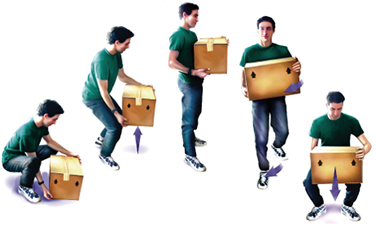Safety & Well-being
Login Tools
My Human Resources
Enter direct banking information, view earnings statements, change your address & manage training. [ LOGIN]
Pension Account
View pension plan balances and investment mix and choose your investments. [ LOGIN]
Manulife
Check and submit claims, get forms, print Manulife card. [ LOGIN]
Faculty Staff Resources
Salary ranges, pay schedules and related information. [ LOGIN]
Researcher Toolbox
Hiring/appointing research roles, including budgeting for salary and benefit costs. [ LOGIN]
Administrator Toolbox
Appointments and pay administration, offer templates. [ LOGIN]
Leader Toolbox
Help with recruiting, hiring, enhancing performance. [ LOGIN]
Western Financial
Submit expenses, PER inquiry, research grants. [ LOGIN]
Manual Materials Handling Guide

General workplace suggestions:
- Utilize job rotation (rotate employees through different jobs)
- Utilize job enlargement (increase variety by involving more tasks or employees in the process)
- Ensure adequate rest periods
- Modify work practices/environment to maintain neutral postures
Lifting
Liftying/Lowering:
- Use mechanized lifts whenever possible
- Minimize the distance loads need to be lifted/lowered
- Avoid storing materials directly on the floor. (use table or shelving so loads can be placed no lower than knuckle height)
- Tag/label unstable/heavy loads
- Reduce the weight of the load by limiting capacity (i.e. smaller containers)
- Clear spaces/paths to improve access to materials being handled
- Stretch before and after lifting heavy loads
- Keep loads as close to the body as possible
- Lift with the legs, not the back
- Keep the back straight, by sticking out the butt and keep your head up looking forward
- Balance lifts on both sides of the body
- Get a secure grip
- Avoid twisting, pivot with the feet instead
- Use both hands if possible
- Use a ladder for overhead loads
Bad Lift
Good Lift
Carrying
Carrying:
- Slide, drag, push or pull loads instead of carrying whenever possible
- Clear a path
- Tag/label heavy/unstable loads
- Reduce capacity of container
- Keep loads close to the body
- Keep loads between knuckle and chest height
- Minimize carrying distance by using wheeled dollies or carts
- When carrying load with one hand, alternate hands throughout the carry
- Use both hands when possible
- Increase size of handles when possible

Pushing/Pulling
Pushing/pulling:
- When possible, push instead of pull
- Clear a path
- Reduce capacity of container to reduce weight of load
- Use wheeled carts/containers whenever possible
- Stagger your legs to generate pushing/pulling force, avoid using your back
- Use entire body to push/pull loads, avoid using the shoulders and arms
- Push and pull with both hands whenever possible
- Use equipment with four swivel wheels or castors to improve control
- Proper maintenance of wheeled carts (lubricate, clean, replace wheels frequently)
Bad Push
Good Push
Workstation Design
Workstation design:
- Height of table should encourage the elbow to relax at 90 degrees
- Workbench height should be adjustable to accommodate the variance in individual height
- Workbench height should be adjusted for the type of work:
- Light work: at elbow height
- Hard work: below elbow height
- Precision work: above elbow height
- Location of workbench should be minimal distance from other necessary tools
- To minimize awkward postures, select tools based on the height of work and surface setup/design:




Published on and maintained in Cascade CMS.
